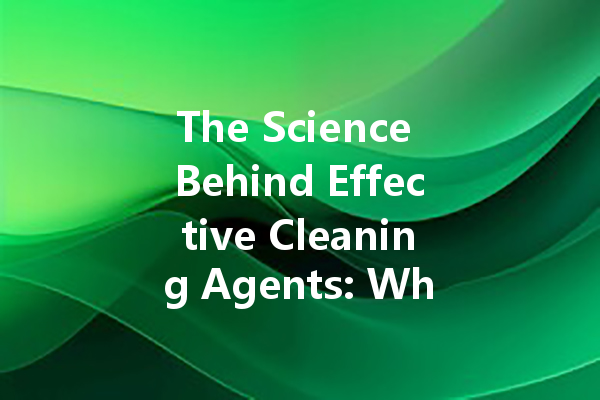Cleaning agents play a crucial role in maintaining cleanliness and hygiene in our homes and workplaces. Understanding the science behind these products can help consumers make informed choices. This article explores the various types of cleaning agents, how they work, and what makes them effective.
什么是清洁剂?
Cleaning agents, also known as cleaning products, are substances used to remove dirt, stains, and impurities from surfaces. They can be categorized into various types, including detergents, disinfectants, degreasers, and abrasive cleaners. Each type has its specific purpose and is formulated to tackle different cleaning challenges.
清洁剂的化学性质
At the heart of any cleaning agent is its chemical composition. Most cleaning agents contain a combination of surfactants, solvents, enzymes, and other additives.
表面活性剂
Surfactants, or surface-active agents, are compounds that lower the surface tension of water, allowing it to spread and penetrate surfaces more effectively. They play a vital role in lifting dirt and grease off surfaces. Surfactants bind to both water and oil, allowing the removal of stubborn stains when rinsed away.
溶剂
Solvents are substances that dissolve other materials. In cleaning agents, solvents help to dissolve dirt and grime, making them easier to remove. Common solvents include alcohol, ammonia, and acetone. They are essential for cleaning tasks that require breaking down tough stains or grease.
酶
Enzymes are natural catalysts that speed up chemical reactions. In cleaning agents, enzymes are often included to target specific types of stains, such as proteins, fats, or carbohydrates. For example, protease enzymes break down protein stains, while lipase enzymes tackle oily residues.
The Role of pH in Cleaning Effectiveness
The pH level of a cleaning agent significantly influences its effectiveness. Cleaning agents can be acidic, neutral, or alkaline, and each pH level is suited for different cleaning tasks.
酸性清洁剂
Acidic cleaners, with a pH below 7, are excellent for removing mineral deposits, rust, and hard water stains. Common examples include vinegar and citric acid-based cleaners, often used in bathrooms and kitchens.
中性清洁剂
Neutral cleaners, with a pH of around 7, are suitable for most surfaces and are safe for regular use. They’re often used in all-purpose cleaners to maintain various surfaces without causing damage.
碱性清洁剂

Alkaline cleaners, with a pH above 7, are effective at cutting through grease and fat. They are commonly found in oven cleaners and degreasers and work well in kitchen applications.
Selecting the Right Cleaning Agent for Your Needs
When choosing a cleaning agent, it’s essential to consider the specific task at hand. Not all cleaning agents are suitable for every surface, and using the wrong product can result in damage.
用于硬质表面
For hard surfaces like tiles and countertops, all-purpose cleaners with surfactants and solvents are usually effective. Ensure the product is safe for the material you are cleaning to avoid scratches or dulling.
For Carpets and Fabrics
When cleaning carpets and fabrics, look for products that contain enzymes and are tailored for fabric care. These products should effectively break down stains without damaging the fibers.
For Disinfecting
If disinfection is the goal, select a product specifically labeled as a disinfectant. These products should meet regulatory standards to effectively kill germs and bacteria.
The Importance of Safety and Environmental Considerations
Understanding the components of cleaning agents extends beyond effectiveness; it’s also about safety and environmental impact.
安全
Always read the labels for safety instructions before using cleaning agents. Some products may contain harsh chemicals that require protective gear, while others may be more eco-friendly. Look for labels that indicate the product is non-toxic or environmentally safe if safety is a primary concern.
环境影响
Many consumers are becoming more conscious about the environmental impact of their choices. Eco-friendly cleaning agents are formulated without harmful chemicals and often use biodegradable ingredients. Researching and opting for these alternatives not only keeps your home clean but also reduces ecological harm.
结论
The science behind effective cleaning agents is rooted in their chemical compositions, mainly involving surfactants, solvents, and enzymes that target specific cleaning challenges. Understanding how these products work can help you choose the right cleaning agent for your needs while being mindful of safety and environmental concerns. The next time you tackle dirt or grime, remembering the science behind your cleaning agents can empower you to make better, informed decisions for a 清洁剂更健康的环境。
